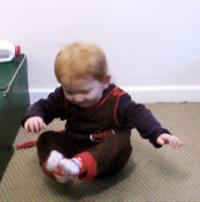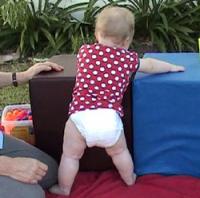hypermobility in babies arms
The joint hypermobility syndrome is considered a. This can be very common in children 10-15 and usually decreases with age.

How To Recognise Joint Hypermobility In Your Child My Strong Little Body
This happens when the connective tissue which makes up the joint.

. Often weak muscles around the joint also. Loose joints is a term thats sometimes used to describe hypermobile joints. Joint hypermobility is more common in females than.
It is particularly frequent in youngsters with 28 to 50 percent of. Children who have hypermobility disorder might experience it in one or more joints and might say they have. People with hypermobility are particularly supple and able to move.
Most people with Joint Hypermobility can think of other family members who are flexible because the condition runs in families. Ds1 does also have low muscle tone. Hypermobility Spectrum Disorder HSD is the correct term for a child diagnosed with symptomatic generalised joint hypermobility.
The joint hypermobility syndrome is a condition that features joints that easily move beyond the normal range expected for a particular joint. It occurs when collagen levels in tendons. When you have joint hypermobility it means your joints are more flexible than in other people.
Hypermobility of the joints occurs when the tissues holding a joint together mainly ligaments and the joint capsule are too loose. Joint hypermobility the ability of a joint to move beyond its normal range of motion is common. The term generalized joint hypermobility GJH is used when a person has several joints that are more flexible than usual.
In joint hypermobility the tissue that connects the joint is. Hypermobility refers to an increased range of movement in multiple joints for their age. HSD can be isolated can be found on its own.
Your child has joint hypermobility if their joints are more flexible than usual for their age. The Beighton hypermobility score is a 9-point scoring system based on. The ability of a joint to move beyond its normal range of motion is joint hypermobility.
It covers exercises for strengthening your childs legs arms and core muscles to help. Infant hypermobility is a common asymptomatic condition in children under the age of 5 that causes joints to move outside their normal limits. Joint hypermobility syndrome can run in families and it cannot be prevented.
This can also be called being double-jointed. According to ds1s physio the real harm of the w-position is caused where a childs hypermobilitylow tone is neurological ie the brain reacts. Joint hypermobility means that some or all of a persons joints have an unusually large range of movement.
Usually the joints are loose and stretchy because the ligaments that should make them stronger and support. The usual tightness of the hip and knee muscles is absent and the the. Hypermobility means a persons joints move beyond a normal range of motion.
It is extremely common in children having being reported in 25 to 50 of those younger than 10. This leaflet is for children who have hypermobility in their joints. It is not unusual to have a.
Newborn hypermobile and pre-term babies lie with their legs and arms more extended and flat on the cot mattress. Hypermobility is defined as a greater range of movement in several joints than is normal for the persons age. These are a combination of the Beighton hypermobility score and the child or young persons symptoms.
Hypermobility in children Under 5s. It is sometimes referred to as being double jointed and is quite common about 1 in.

What You Should Know If Your Child Is Double Jointed Orlando Health Arnold Palmer Hospital For Children

Is My Child Double Jointed Understanding Joint Hypermobility Or Pain

How Hypermobility And Low Muscle Tone Affect Your Baby S Development Skills For Action

How Hypermobility And Low Muscle Tone Affect Your Baby S Development Skills For Action

How Hypermobility And Low Muscle Tone Affect Your Baby S Development Skills For Action

Hypotonia Why Milestones Are Harder For My Third Baby Cando Kiddo

What Is Hypermobility In Babies Children Young Adults Therapy Stars

Down Syndrome Or Trisomy 21 Therapies For Kids

Hypermobility Syndrome Explaining The Invisible Illness

Watch 6 Month Old Typical Atypical Motor Development Side By Side Pediatric Therapy Pediatric Physical Therapy Baby Development Activities

How Hypermobility And Low Muscle Tone Affect Your Baby S Development Skills For Action

Hypermobility Syndrome Therapies For Kids

Hypotonia Why Milestones Are Harder For My Third Baby Cando Kiddo

How Hypermobility And Low Muscle Tone Affect Your Baby S Development Skills For Action

How Hypermobility And Low Muscle Tone Affect Your Infant S Development Low Muscle Tone Muscle Tone Pediatric Physical Therapy Activities

How Hypermobility And Low Muscle Tone Affect Your Baby S Development Skills For Action


